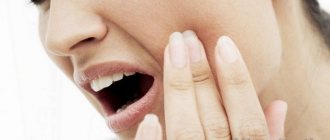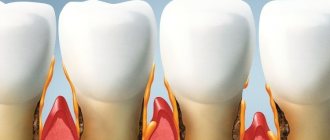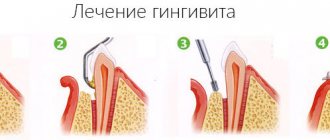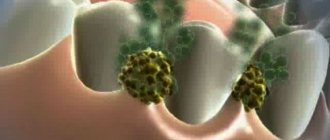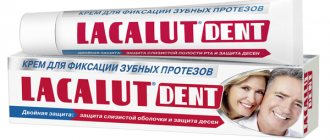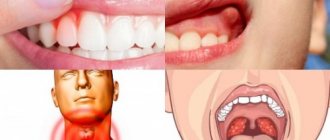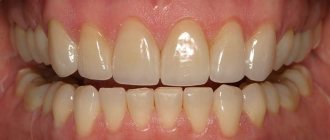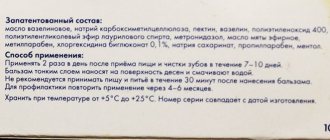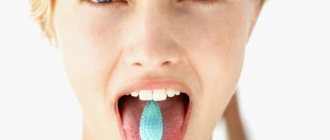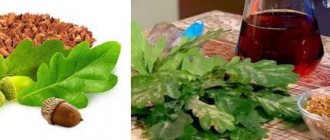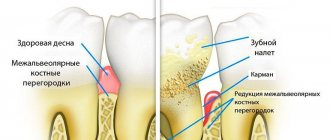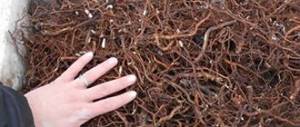Anyone who has had gum pain knows very well that this is a rather unpleasant condition. Reasons may include neglect of hygiene, pregnancy, vitamin deficiency, etc.
There are simple folk remedies for inflammation:
- herbal masks;
- special medicinal chewing gum;
- tinctures;
- herbal decoctions;
Let's consider each method separately.
Masks
It is recommended to perform this procedure after eating, after brushing your teeth in advance:
- Beet. Peel and finely grate. After this add Art. l. sunflower oil. Apply to gums and wait 20 minutes. The procedure is performed every 6 hours.
- Potato. It is thoroughly washed with water and finely passed through a grater together with the peel. The resulting mass must be applied for 20 minutes. The course of treatment is 7 days.
- Banana peel. The peel is dried and thoroughly crushed. 1 tbsp. l. the resulting mass is mixed with 3 tbsp. l. sea salt crushed in a coffee grinder. Then olive oil is added until the mixture has the consistency of sour cream. The mixture is spread on the inflammatory focus for 10 minutes. The procedure is performed twice a day with a course of 10 days.
- They take galangal, spice cloves and dried bergenia roots. All ingredients are ground in a coffee grinder and mixed with tooth powder. The resulting mask is first applied to the gums for 3 minutes, and then the teeth are brushed with this mixture, placing it on a toothbrush. This drug is recommended to be used as a preventative measure 2-3 times a week.
After masks, you need to rinse your mouth with a herbal decoction.
Medicinal gum
Take 75 grams of beeswax, a tablespoon of honey, 5 drops of mint essential oil and a couple of drops of lemon juice. First, the wax is melted in a water bath, and then the remaining ingredients are added to it one after another.
It is recommended to chew beeswax throughout the day at any time.
The resulting hot mixture is stirred until smooth and left to cool. Then lozenges of various shapes and sizes are created.
Infusions
Pumpkin juice is good for relieving gum inflammation
Effective against the inflammatory process:
- Alder. Take a handful of cones and grind them in a blender. The resulting mass is poured with 200 ml of boiling water and allowed to brew for 1 hour. After this, the drink is filtered. It is necessary to rinse a couple of times a day until recovery occurs.
- Golden mustache. Grind the leaf of the plant, and then add 1 cup of boiling water. Mix with 1/2 tsp. sea salt, after which it is infused in a container with a closed lid for several hours and filtered through a sieve. You should rinse your mouth with this infusion twice a day.
- Celandine. This plant is finely chopped to fill a half-liter jar. Celandine is poured with vodka and allowed to brew for 1 week. It is recommended to rinse the mouth with the resulting infusion in the morning and evening. Dilute with water before use. The liquid must not be swallowed! The course of treatment is 7 days. They also use the juices of some plants to reduce inflammation:
- Pumpkin juice. Pass the mature pumpkin through a juicer or a grater and squeeze the mixture through cheesecloth. The juice should be rinsed in the mouth morning and evening; it is effective against gum inflammation caused by hypovitaminosis.
- Aloe. Leave the leaves of the plant in the freezer overnight, and in the morning finely chop it and extract the juice. They lubricate the gums 3-4 times a day until recovery occurs.
Why does baking soda help against toothache?
This substance has a therapeutic effect on the entire oral cavity, namely:
- Relieves inflammation and reduces swelling.
- Has antibacterial properties.
- Disinfects affected areas of the gums.
- Normalizes the acid-base balance in the oral cavity.
- Freshens breath.
Indications:
- Caries;
- bleeding gums or discomfort due to periodontitis;
- after deleting a unit and other operations;
- stomatitis;
- tooth sensitivity.
Contraindications:
- Increased sensitivity of enamel;
- inflamed gums;
- with caution: after any dental surgery;
- Use cautiously during pregnancy.
Important! Avoid swallowing even a small amount of soda solution. Ingestion may cause burns to the mucous membrane of the esophagus and stomach.
Excessive use of rinsing with this product for a long time contributes to irritation of the oral mucosa.
A soda-salt solution for mouth rinsing, made in the correct proportions, is not capable of having a significant harmful effect. However, for some diseases and individual characteristics, a healing folk remedy can cause considerable harm to the patient’s health.
Young children should not rinse their mouths with soda-based products, even with severe toothache. Children under 3–4 years old do not yet understand the essence and technique of the procedure and can swallow a significant amount of liquid, which is why it is better to dip a cotton or gauze swab into the medicinal composition and help the baby treat the mucous membranes of the oral cavity by simply wiping.
The drug may cause harm if you have a traumatic brain injury, brain disease, or a predisposition to stroke. In addition, you can significantly worsen your health if you take it orally.
Despite the fact that baking soda is used in the treatment of toothache as an adjuvant, soda baths for teeth help dull pain, relieve inflammation and disinfect the oral cavity.
Although there are many skeptics who do not believe in the effectiveness of soda for toothache, it can have the following positive effects:
- Acids and bacteria are the main factors leading to caries. Soda, helping to neutralize acids, does not allow microorganisms to spread in the oral cavity, adversely affecting the acidity of the mucous membrane.
- Sodium bicarbonate has a softening effect and helps reduce the inflammatory process not only in the gum tissue, but also in the tooth itself.
- It has a cleansing effect, helping to remove food debris from hard-to-reach places between the incisors, and thereby prevents the appearance of putrefactive processes in the teeth.
- Sodium bicarbonate is a powerful antiseptic, especially in combination with soda and hydrogen peroxide, which has an excellent bactericidal effect on teeth.
- Soda does not irritate inflammatory areas of mucous tissue in the oral cavity.
- A mixture of soda, hydrogen peroxide and toothpaste is an effective whitening agent that helps remove plaque from teeth, which consists of harmful formations, including microorganisms that affect not only the condition of the teeth, but also the digestive organs.
Since baking soda is a substance that housewives constantly have in their kitchens, you can always use it if you suddenly experience pain in your teeth.
How to prepare a decoction?
Herbal decoctions are an excellent remedy for inflammation and swelling of the gums. If you are not allergic to these plants, you can gently and effectively relieve the symptoms of the disease.
Oak bark and sage:
- Take these ingredients and mix in equal proportions.
- To 1 tbsp. l. Add 1 cup of boiling water to the resulting mixture.
- Allow the solution to cool.
- Rinse every 4 hours. The course of treatment is 10 days.
Take yarrow, oak bark and St. John's wort, 1 tablespoon each:
- All components are mixed.
- Pour 400 ml of water.
- Boil the mixture for 5-6 minutes over low heat.
- Let cool and rinse every 4 hours.
The course of treatment is 1 week.
Sage, oak bark and eucalyptus leaf:
- They take the ingredients and mix them together.
- 1 tbsp. l. vegetable raw materials are poured into a thermos.
- Add 500 ml of boiling water.
- Let it brew for 5 hours.
- Strain and then rinse 7-8 times a day.
Use until inflammation disappears.
Calendula and chamomile:
- Take herbal ingredients one tablespoon at a time.
- Pour in 400 ml of water.
- Boil in a water bath for 7 minutes.
- Leave for 3 hours.
- Rinse every 5 hours until inflammation subsides.
Treatment rules
Treatment goals for gum disease:
- Remove plaque.
- Remove tartar.
- Relieve inflammation.
- Follow preventive measures to avoid relapses.
Therapy is prescribed based on the stage of the disease:
- In stage 1: the dentist performs professional cleaning of tartar and soft plaque. Folk remedies are used to relieve inflammation and reduce pain.
- Stage 2: removal of dental plaque and antimicrobial therapy. Folk remedies are also used at this stage to reduce bleeding and eliminate bad breath.
- In stage 3: in addition to the listed measures, splinting of mobile teeth, the use of antibiotics to suppress suppuration from periodontal pockets and surgical treatment of periodontitis are added.
Risks of self-medication
Sudden toothache worsens general well-being, interferes with eating, sleeping and working fully. Before visiting the dentist, you can relieve discomfort with folk remedies.
However, you should not delay visiting a doctor, since prolonged self-medication can have negative consequences: the inflammatory process will worsen, and the treatment will become serious and lengthy.
So, only a dentist can help you completely get rid of toothache. However, traditional medicine recipes based on soda and other available ingredients will help to alleviate the condition for a while in order to eat peacefully and sleep at night.
Even if the pain goes away within 24 hours, do not put off visiting a doctor, because baking soda does not cure, but only temporarily eliminates symptoms.
Stages of inflammation
periodontitis
Depending on the severity of the inflammatory process, 3 stages are distinguished.
They are independent diseases in themselves:
- Periodontal disease: characterized by slight redness of the gums, burning and itching.
- Gingivitis: bleeding and sensitivity of the gums, especially when brushing your teeth. Swelling, bad breath and pain when chewing food appear.
- Periodontitis: spread of inflammation to the tissue around the teeth and bones of the skull. The gums are loose and swollen, suppuration from periodontal pockets. Loosening and loss of teeth occurs.
Symptoms indicating the need to strengthen gums
- Sagging soft tissues, the presence of pockets between the gum and tooth.
- Bleeding, swelling and redness.
- Receding gums, exposure of tooth roots.
- The appearance of their mobility.
- Discharge of pus.
The listed signs are associated not only with discomfort and unpleasant odor. They indicate the development of processes that can lead to dire and irreversible consequences. If the problem is ignored, teeth (including healthy ones) may begin to loosen and fall out. Therefore, if you have at least one of the symptoms, you should think about how to cure and strengthen your teeth gums at home, because for this it is not at all necessary to seek medical help.
Causes
There are many sources of the disease. The most common of them:
- Poor oral hygiene.
- The appearance of tartar.
- Weakening of the immune system.
- Hypovitaminosis, vitamin deficiency.
- Burdened heredity.
- Pregnancy and hormonal imbalance.
- Tobacco smoking.
- Drinking alcohol, coffee.
- Taking medications that reduce salivation.
- Poor quality fillings and dental crowns that injure the gums.
- Menstrual cycle.
- Diseases of the gastrointestinal tract.
Features of purulent lesions and benefits of aloe
The formation of purulent exudate occurs when bacterial, fungal or protozoan pathogens enter the tissue. Any of them can cause the development of inflammatory processes, resulting in the accumulation of fluid consisting of protein molecules, destroyed leukocytes and macrophages. The contents melt and an abscess is formed.
As a rule, the abscess matures within a week, then the wound is opened and pus comes out of it. At the final stage of the abscess, the damaged tissue is restored, the wound heals, becoming covered with smooth skin or scarring.
Unfortunately, the purulent mass cannot always come out of the abscess on its own. Often it accumulates deep in the tissues, and the pus must be given time to rise to the surface layers. However, in this case, there is a risk of complications when particles of a severe skin abscess can penetrate into the bloodstream, causing the development of sepsis.
To avoid complications, it is recommended to use external medications that can draw pus from the wound to the surface, as well as have a healing, regenerating effect on the affected tissue. Aloe juice has a similar effect; its active substances stimulate the outflow of purulent fluid that accumulates in wounds, preventing the progression of an abscess.
When treating purulent wounds, medications with aloe extract can quickly achieve positive results:
- numb the damaged area;
- reduce the inflammatory process;
- eliminate microbial flora and disinfect the wound;
- soften tissue and restore damaged areas.
Additionally, aloe's effects extend to the immune system. The plant is a biogenic stimulant; it activates and supports the immune system, which fights hostile agents. Therefore, for skin diseases and injuries, it is recommended to take aloe juice and preparations with this component orally.
We suggest you familiarize yourself with White nodules on the throat
